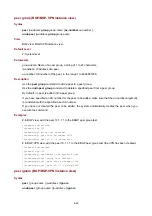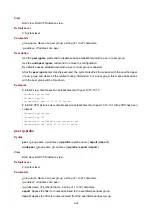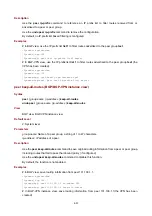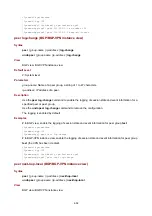
6-69
Examples
# Disable route reflection between clients.
<Sysname> system-view
[Sysname] bgp 100
[Sysname-bgp] undo reflect between-clients
reflector cluster-id (BGP view)
Syntax
reflector cluster-id
{
cluster-id
|
ip-address
}
undo reflector cluster-id
View
BGP view
Default Level
2: System level
Parameters
cluster-id
: Cluster ID in the format of an integer from 1 to 4294967295.
ip-address
: Cluster ID in the format of an IPv4 address in dotted decimal notation.
Description
Use the
reflector cluster-id
command to configure the cluster ID of the route reflector.
Use the
undo reflector cluster-id
command to remove the configured cluster ID.
By default, each route reflector uses its router ID as the cluster ID.
Usually, there is only one route reflector in a cluster. The router ID of the route reflector is the ID of the
cluster. You can configure multiple route reflectors to improve network stability. In this case, using this
command can configure the identical cluster ID for all the route reflectors to avoid routing loops.
Related commands:
reflect between-clients
and
peer reflect-client
.
Examples
# Set the cluster ID to 80.
<Sysname> system-view
[Sysname] bgp 100
[Sysname-bgp] reflector cluster-id 80
refresh bgp
Syntax
refresh bgp
{
all
|
ip-address
|
group group-name
|
external
|
internal
} {
export
|
import
}
View
User view
Default Level
1: Monitor level
















































